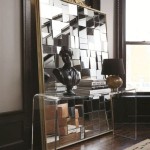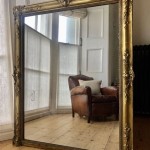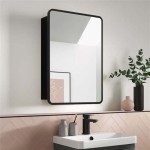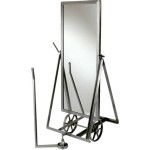How To Hang a Heavy Mirror on Drywall
Hanging a heavy mirror on drywall requires more than just a simple nail and hammer. Proper installation ensures the mirror's safety and prevents damage to the wall. This process involves careful planning, the right hardware, and precise execution.
The first step is assessing the mirror's weight. Knowing the exact weight is crucial for selecting appropriate hanging hardware. Bathroom scales or luggage scales can provide an accurate measurement. This information guides decisions regarding the type of anchors and hanging wires needed.
Next, locate wall studs using a stud finder. Studs provide the most secure anchoring points, especially for heavier items. Mark the stud locations with a pencil. If the desired mirror placement doesn't align with studs, heavy-duty drywall anchors are necessary.
Choosing the correct hardware is paramount. Several options exist, each suited to different weights and wall types. For mirrors weighing less than 20 pounds, heavy-duty picture hooks might suffice. However, for heavier mirrors, toggle bolts, molly bolts, or D-rings and wire are recommended. Toggle bolts and molly bolts provide robust anchoring within the drywall itself. D-rings attached to the back of the mirror, combined with picture wire and appropriately rated hooks, offer a stable hanging solution for heavier weights distributed across multiple points.
Before drilling any holes, carefully measure and mark the desired mirror position on the wall. Use a level to ensure the markings are perfectly horizontal. Precise measurements prevent crooked hanging and ensure the mirror sits flush against the wall.
If using anchors, drill pilot holes of the appropriate size for the chosen anchor type. Follow the manufacturer's instructions for proper installation. For D-rings, measure and mark their placement on the back of the mirror, ensuring they are level and equidistant from the center. Securely attach the D-rings using screws appropriate for the mirror's frame material. Thread picture wire through the D-rings, leaving enough slack to form a triangle when hung on the hook or hooks.
When using studs, install appropriately rated screws directly into the studs. Ensure the screws protrude sufficiently to support the hanging hardware. For D-ring installations, measure the distance between the D-rings and transfer this measurement to the wall, marking where the screws or hooks should be placed. This ensures proper alignment and a balanced hang.
Heavy mirrors often require two or more hanging points to distribute the weight evenly. This is especially true for larger, wider mirrors. Multiple hanging points enhance stability and prevent excessive stress on any single anchor or screw. When using multiple hooks or screws, meticulously level each point to ensure the mirror hangs correctly.
For exceptionally heavy mirrors, consider using French cleats. A French cleat system consists of two interlocking pieces of wood, one attached to the wall and the other to the back of the mirror. This system provides a robust and secure mounting solution capable of supporting substantial weight. Ensure the wall cleat is securely fastened to studs or heavy-duty anchors.
After installing the chosen hanging hardware, carefully lift the mirror and position it on the hooks or screws. Ensure the mirror is seated securely and flush against the wall. Gently tug on the mirror to test the stability of the installation. If the mirror feels loose or wobbly, re-evaluate the chosen hardware and ensure proper installation.
Using the right tools simplifies the process and enhances safety. Essential tools include a stud finder, level, drill, appropriate drill bits, screwdriver, measuring tape, and a pencil. Having these tools readily available streamlines the installation process and minimizes potential complications.
Safety precautions are paramount when handling heavy objects. Wearing gloves protects hands from sharp edges and potential splinters. Enlist a helper for lifting and positioning heavy mirrors to avoid injury and ensure proper alignment during installation. Having assistance greatly reduces the risk of dropping the mirror and causing damage or personal injury.
Consider the wall's construction when planning the installation. Drywall varies in thickness and composition. Ensure the chosen anchors and screws are appropriate for the specific type of drywall being used. Consulting a professional installer is recommended for particularly heavy mirrors or if there are concerns about the wall's structural integrity.
Different mirror types may require specific hanging methods. Framed mirrors often have built-in wire or D-rings, while frameless mirrors might require specialized adhesive hangers or clips. Research the recommended hanging method for the specific mirror type being installed. This ensures proper support and minimizes the risk of damage.
Lighting and placement influence the mirror's functionality and aesthetic impact. Consider the room's lighting and the intended use of the mirror when choosing a location. Ensure adequate lighting for tasks such as applying makeup or shaving. Positioning also affects the room's perceived size and brightness.
How To Hang A 100 Pound Mirror On Drywall Quora

How To Hang A Heavy Mirror On Drywall Stas Picture Hanging Systems

How To Hang A Large Or Heavy Mirror

How To Hang A Heavy Mirror With French Cleat

A Better Way To Hang Heavy Mirror Hanging Pictures

How To Hang A Heavy Mirror

How To Hang A Heavy Mirror

How To Hang A Very Heavy Picture Or Mirror The Best

How To Hang A Heavy Mirror With Pictures Wikihow

How To Hang A Heavy Mirror C R F T







